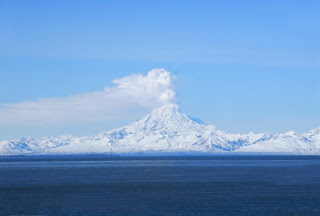
The Alaska Volcano Observatory has reported that the remote Pavlof Volcano continues to erupt and is now spewing lava, ash and steam 20,000 feet into the sky, which has been traveling southeast towards the Gulf of Alaska since Thursday.
The 8,000-foot volcano has been emitting a steady cloud of volcanic ash that now extends some 60 miles. The Alaskan volcano is located 625 miles southwest of Anchorage. Residents of Cold Bay, which is 37 miles away, have reported seeing a glow from the summit.
“Pavlof Volcano continues to erupt. Lava fountaining at the summit has been observed and photographed, and a continuous ash, steam, and gas cloud generated by the activity extends downwind from the volcano for 50 to 100 km at an altitude of about 20,000 ft above sea level,” AVO posted on its website.
“This morning the cloud was carried to the southeast. Satellite images show persistent elevated surface temperatures at the summit and on the northwest flank, commensurate with the summit lava fountaining and resulting lava flow. Seismic activity remains elevated with nearly continuous tremor recorded on the seismic network.”
On Thursday the Alaska Volcano Observatory noted that the current volcano alert level was at a “watch” stage while the current aviation color code was at “orange.” These are the indicators used by the US Geological Survey’s Volcano Hazards Program, which is used to track volcanic activity in the United States.
Along with another named Cleveland, Pavlof is one of two Alaskan volcanoes that are on “watch” status due to heightened activity. The orange indicator relates to how the rumblings could affect planes flying over the summit. There are four volcano alert levels that use the terms Normal, Advisory, Watch and Warning.
‘Normal’ indicates a typical background, non-eruptive state; ‘advisory’ indicates that the volcano may be exhibiting signs of elevated unrest above the known background level; ‘watch’ is for those volcanoes that are exhibiting heightened or escalating unrest, and which have an increased potential of eruption, or in which an eruption is underway but poses only limited hazards; and a ‘warning’ is for those occasions when a hazardous eruption is imminent, underway or suspected.
Pavlof has had nearly 40 known eruptions to date, making it the most active volcanoes in the Aleutian arc and “one of the most historically active volcanoes in the North Hemisphere,” USGS scientist John Powers told CNN. He added that Cleveland is also very active and had its last large eruption in 2001.
The USGS tracks 11 volcanoes. In addition to Cleveland and Pavlof, the Hawaiian volcano of Kilauea is also at a “Watch Orange” stage, while Pagan in the North Mariana Islands is at “Advisory Yellow.” Six other volcanoes are currently at “Normal Green,” while the Hawaiian Lo’ihi volcano remains unassigned.
Note : The above story is reprinted from materials provided by Peter Suciu for redOrbit
The Alaska Volcano Observatory (AVO) is a joint program of the United States Geological Survey (USGS), the Geophysical Institute of the University of Alaska Fairbanks (UAFGI), and the State of Alaska Division of Geological and Geophysical Surveys (ADGGS).









